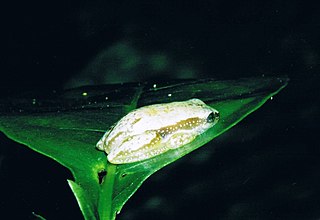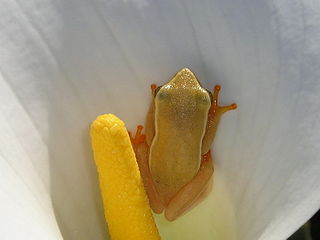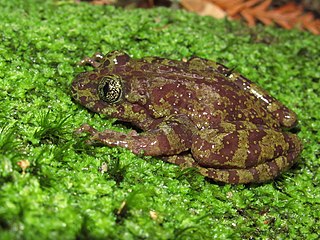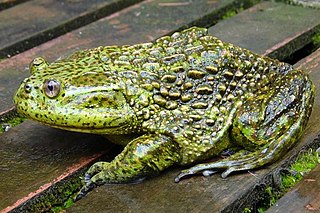
Amphibians of Australia are limited to members of the order Anura, commonly known as frogs. All Australian frogs are in the suborder Neobatrachia, also known as the modern frogs, which make up the largest proportion of extant frog species. About 230 of the 5,280 species of frog are native to Australia with 93% of them endemic. Compared with other continents, species diversity is low, and may be related to the climate of most of the Australian continent. There are two known invasive amphibians, the cane toad and the smooth newt.

The wildlife of South Africa consists of the flora and fauna of this country in southern Africa. The country has a range of different habitat types and an ecologically rich and diverse wildlife, vascular plants being particularly abundant, many of them endemic to the country. There are few forested areas, much savanna grassland, semi-arid Karoo vegetation and the fynbos of the Cape Floristic Region. Famed for its national parks and big game, 297 species of mammal have been recorded in South Africa, as well as 849 species of bird and over 20,000 species of vascular plants.

The western leopard toad is a species of toad in the family Bufonidae. The species is endemic to the low-lying areas of the Cape Peninsula, the Cape Flats and the Agulhas flats of the Western Cape, South Africa.

The green-eyed treefrog is a species of Australasian treefrog in the subfamily Pelodryadinae that occurs in the Wet Tropics of Australia.

The golden banana frog, golden dwarf reed frog, golden spiny reed frog, or golden leaf-folding frog is a species of frog in the family Hyperoliidae. It is found in lowland coastal plains of eastern South Africa, Eswatini, and southern Mozambique. The AmphibiaWeb includes Afrixalus crotalus in this species as a subspecies, whereas the Amphibian Species of the World and the IUCN Red List of Threatened Species treat A. crotalus as a full species.

Afrixalus, commonly known as the banana frogs, spiny reed frogs, cat's eye reed frogs, or leaf-folding frogs, is a genus of frog in the family Hyperoliidae. They occur in the Subsaharan Africa. They lay their eggs in vegetation above water, often folding leaves around the eggs for protection—hence the common name "leaf-folding frogs".

Afrixalus crotalus is a species of frogs in the family Hyperoliidae. It is found in southern Malawi, central Mozambique, and eastern Zimbabwe. It might be a subspecies of Afrixalus aureus, a position adopted by the AmphibiaWeb. It is sometimes known as the Zimbabwe banana frog or snoring spiny reed frog.

Afrixalus delicatus, the delicate leaf-folding frog, delicate spiny reed frog or Pickersgill's banana frog, is a species of frogs in the family Hyperoliidae. It is found in Southern and Eastern Africa, from eastern South Africa and Eswatini northward through Mozambique, the low altitude parts of Malawi and Tanzania, southeastern Kenya to southern Somalia.
Afrixalus equatorialis, also known as the Congo banana frog, is a species of frog in the family Hyperoliidae. It is found in the central parts of the Congo Basin in the Democratic Republic of the Congo and southeastern Cameroon, and is likely to be found in the Republic of the Congo and the Central African Republic too. It might be conspecific with Afrixalus nigeriensis and is closely related to Afrixalus leucostictus.

Afrixalus fornasini is a species of frog in the family Hyperoliidae and is native to Africa. Its common name is Fornasini's spiny reed frog or the greater leaf-folding frog
The Nigeria banana frog is a species of frog in the family Hyperoliidae. It is found in southeastern Guinea, Liberia, Ivory Coast, Ghana, and western Nigeria; it appears to be missing from Togo and Benin. Its natural habitat is primary rainforest, but it can also occur in farm bush. The eggs are laid on vegetation overhanging temporary ponds. It is threatened by habitat loss caused by agricultural encroachment, expanding human settlements, and logging. A high prevalence of Batrachochytrium dendrobatidis, the fungus causing chytridiomycosis that has been associated with amphibian declines elsewhere, has been demonstrated in specimens collected from the Okomu National Park in Nigeria.

The Natal banana frog is a species of frog in the family Hyperoliidae. It is found in South Africa and possibly Lesotho. Its natural habitats are temperate forests, temperate shrubland, swamps, intermittent freshwater marshes, arable land, rural gardens, ponds, and canals and ditches. It is threatened by habitat loss.

The arum frog, Horstock's arum-frog, arum lily frog, or Horstock's reed frog is a species of frog in the family Hyperoliidae. It is endemic to South Africa.

Bilbo's rain frog is an amphibian species in the family Brevicipitidae, endemic to South Africa. The frog was named after Bilbo Baggins, the main character from The Hobbit by J.R.R Tolkien. The frog was named as such because the scientist who discovered it used to read the novel to his children. Its natural habitats are temperate grasslands and edges of wood plantations, wherein it spends most of its time in its burrow. The species is threatened by construction, maintenance of roads, silviculture, general habitat degradation/habitat loss, and by road traffic. As a result, it is listed as Near Threatened in the IUCN Red List of Threatened Species.
The Bainskloof moss frog or Bainskloof chirping frog is a species of frogs in the family Pyxicephalidae. It is endemic to South Africa.

The micro frog, or Cape Flats frog, is a species of frog less than 2 cm (0.8 in) long in the family Pyxicephalidae, in the monotypic genus Microbatrachella. Its color varies from rufous brown with dark mottling, to tan or green, depending on the population. It is endemic to the south-western Cape area of South Africa, with a single population found on the Cape Flats of Cape Town and several populations on the eastern side of False Bay. It typically lives in wetlands in coastal fynbos habitats, but its total area of occupancy is very small, and the International Union for Conservation of Nature has rated it as being "critically endangered".

The banded stream frog, also known as the banded sand frog, Cape grass frog, Cape stream frog, long-toed frog, mountain frog or Jonkersberg frog, is a species of frogs in the family Pyxicephalidae. It is endemic to South Africa.

Rose's ghost frog, or Table Mountain ghost frog, is a species of frog in the family Heleophrynidae endemic to South Africa. It is a medium-sized species with purple or brown blotches on a pale green background and large discs on its fingers and toes. It has a very restricted range, being only known from the slopes of parts of Table Mountain. The tadpoles live in permanent streams but these are in danger of drying up because of the establishment of pine plantations. Because of its small range and changes in its habitat, this frog is listed as critically endangered by the International Union for Conservation of Nature.

Calyptocephalella is a genus of frogs in the family Calyptocephalellidae. It is represented by a single living species, Calyptocephalella gayi, commonly known as the helmeted water toad, Chilean helmeted bull frog or wide-mouth toad. Additionally, there are a few extinct species that only are known from Late Cretaceous and Paleogene fossil remains from Patagonia in South America and in the Antarctic Peninsula. The helmeted water toad living today is aquatic to semi-aquatic, and found in deep ponds and reservoirs in central Chile and possibly adjacent west-central Argentina.

Natal diving frog, also known as the Natal diving frog, Boneberg's frog, or Kloof frog ), is a species of frog in the family Pyxicephalidae. It is the only species within the monotypic genus Natalobatrachus. It is endemic to South Africa. Its natural habitats are temperate forests and rivers and it is threatened by habitat loss.

















